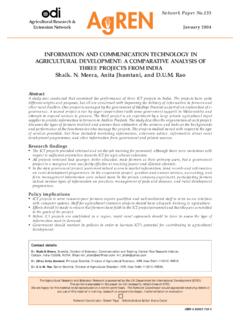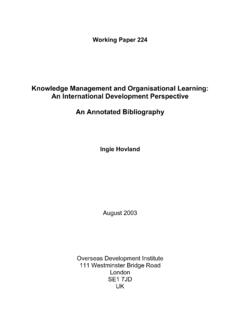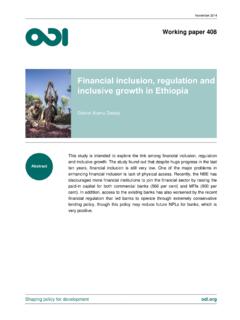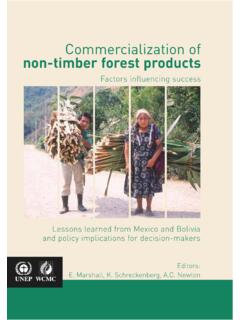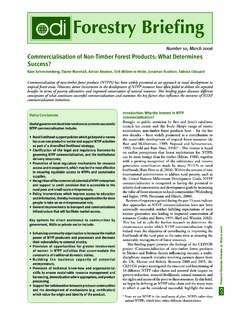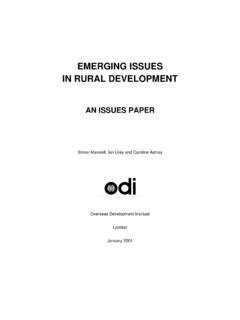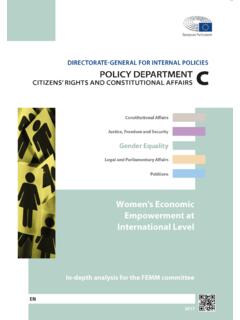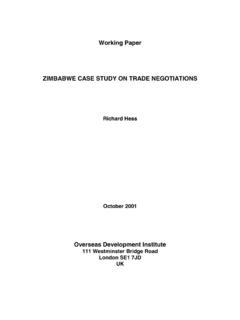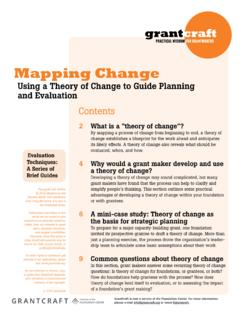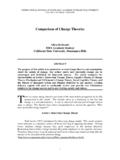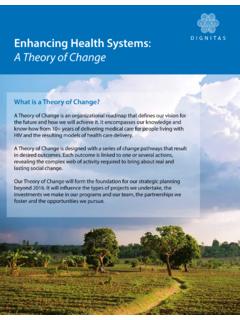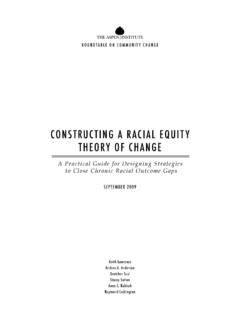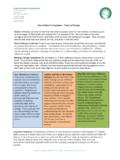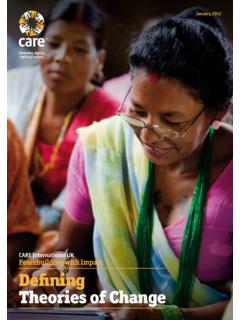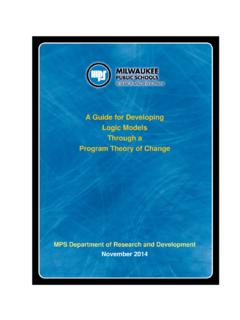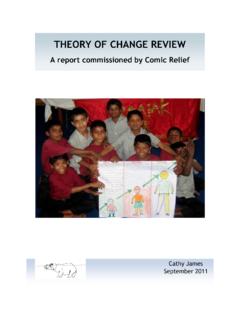Transcription of Theories of Change - Overseas Development Institute
1 December 2014 Theories of Change Time for a radical approach to learning in developmentCraig ValtersSeptember 2015 Overseas Development Institute203 Blackfriars RoadLondon SE1 8 NJTel. +44 (0) 20 7922 0300 Fax. +44 (0) 20 7922 0399 E-mail: are encouraged to reproduce material from ODI Reports for their own publications, as long as they are not being sold commercially. As copyright holder, ODI requests due acknowledgement and a copy of the publication. For online use, we ask readers to link to the original resource on the ODI website. The views presented in this paper are those of the author(s) and do not necessarily represent the views of ODI. Overseas Development Institute 2015. This work is licensed under a Creative Commons Attribution-NonCommercial Licence (CC BY-NC ).ISSN: 2052-7209 Cover photo: Footprint books, Angus Dawson: Mountain Pass, Morocco2 ODI ReportContentsAcknowledgements 4 Introduction 4 What is a theory of Change approach and why does it matter?
2 5 What are some key principles of a theory of Change approach? 7 Principle 1: Focus on process 7 Principle 2: Prioritise learning 8 Principle 3: Be locally led 10 Principle 4: Think compass, not map 11 Theories of Change and the results agenda 13 Conclusion: modest radicalism 16 References 17 Theories of Change Time for a radical approach to learning in Development 3 1 This paper does not use the term ToCs . This is partly because it implies a singular approach, when in fact there are a number of approaches, as evidenced by the diversity of practice demonstrated at the April 2015 workshop and outlined below. Furthermore, using acronyms can be alienating for Workshop materials, including the agenda, presentations and a summary, are all available online: ODI ReportAcknowledgementsThe author would like to thank all those who attended the workshop, Theories of Change in International Development , held at the Overseas Development Institute (ODI) in April 2015.
3 ODI, through an Accountable Grant with the Department for International Development , and The Asia Foundation, co-funded the workshop and this paper. The author is particularly grateful to The Asia Foundation for ongoing support. This paper builds on research conducted as part of the collaboration between the Justice and Security Research Programme (JSRP) and The Asia Foundation. A discussion paper was circulated before the workshop and formed the basis for discussion. The author is grateful to Simon Hearn (ODI), Richard Allen (Cranfield University) and Cathy Shutt for useful comments on this. This post-workshop paper has benefited from a substantial number of comments and reviews, including from Patrick Barron (The Asia Foundation), Claire Bracegirdle (ODI), Pilar Domingo (ODI), Heather Lanthorn (Harvard School of Public Health), David Lewis (London School of Economics), Hamish Nixon (ODI), Mareike Schomerus (ODI) and Leni Wild (ODI). All interpretation of their points and any errors or omissions made are the author s own.
4 The author is grateful to Roo Griffiths for editorial supportIntroductionThe theory of Change approach,1 with its focus on continuous critical reflection, demands a radical shift towards more and better learning in Development thinking and practice. No new tool or approach can in itself address problems of institutional incentives in the sector that block such learning. However, a theory of Change approach may be able to create a productive (albeit small) space for critical reflection in this industry a challenging and much-needed aim. This paper, drawing on recent research and a workshop held at the Overseas Development Institute (ODI) in April 2015,2 outlines the growing and diverse ways in which theory of Change approaches are understood. It takes the key findings of recent research (Valters, 2014) a step further, by outlining and justifying four key principles when using a theory of Change approach, tied into a deeper analysis of the Development sector.
5 The paper highlights throughout examples of the organisational use of Theories of Change , each of which attempts to go some way towards addressing the criticisms of the approach to date (James, 2011; Stein and Valters, 2012; Valters, 2014; Vogel, 2012). It also analyses possibilities for taking these principles forward in light of the results agenda . What is a theory of Change approach and why does it matter? Thinking within the Development industry on how Change happens and how to build more effective interventions to influence Change goes on. Numerous iterations of different programme management tools, discourses and approaches have either failed to stick or been corrupted by perverse incentives and practices within the aid industry which often encourages their reinvention or re-labelling. As the quote above implies, the industry has long been struggling with the complexity of the social processes with which it engages. Recent mainstream acknowledgements of how little Development practitioners recognise their own biases and assumptions have strengthened the case for serious reflection on the state of learning in the industry as a whole (World Bank, 2015).
6 What is it?The current iteration of the theory of Change approach emerged from both evaluation and informed social practice (Vogel, 2012), and has become a mainstream discourse, tool and approach. Outlining a theory of Change involves at its most basic making explicit a set of assumptions in relation to a given Change process. The most useful definitions help reflect the need to move beyond static programme theory 3 and into a more reflective and adaptive understanding of Change . James (2011) suggests the following: A theory of Change is an ongoing process of reflection to explore Change and how it happens and what that means for the part we play in a particular context, sector and/or group of people. While this remains rather broad, this definition makes it clear analysis should be about both how Change in a given context occurs and what ongoing role individuals and organisations can play. This definition helps tackle a recurrent problem with Theories of Change that organisations imply that Change in a society revolves around them and their programme, rather than around a range of interrelated contextual factors, of which their programme is part.
7 theory of Change has become pervasive as a discourse: it has become standard Development etiquette to ask, What is your theory of Change for that? in meetings and seminars. This reflects the basic definition above, simply meaning how and why a given intervention is going to work. As a tool, for many, theory of Change is like an extension of the assumptions column of the logframe. If developing Theories of Change is to be useful here, it will be part of a critical and evidence-based attempt to unpack the black box of causality between what (in aid jargon) are termed inputs, outputs and outcomes. Taking a theory of Change approach will likely include use of a tool in some form, but is broader, reflecting a desire to embed a critical and adaptive approach to Development thinking and practice in organisational practice (Stein and Valters, 2012). As Stein and Valters (2012) detail more extensively, Theories of Change fulfil a number of different purposes, including strategic planning, communication, accountability and learning.
8 For example, an organisation may use Theories of Change as a way to communicate their goals to funders, but also to promote internal learning on programme strategy. They can also be completed at a number of different levels, including macro, sectoral, organisational and project/programme (James, 2011). While the basic idea of making explicit and critically assessing assumptions of Change processes remains on each level, it is a very different task to develop an overarching organisational theory of Change (perhaps more simply understood as a vision statement) than it is to develop implementation Theories of Change that speak closely to diverging realities at the local level. If control-oriented planning and management are neither effective nor appropriate in coping with complexity and uncertainty, what alternatives do planners and administrators have for dealing with Development problems more effectively? (Rondinelli, 1983)3 Funnel and Rogers (2011) make a distinction between a theory of Change and a theory of Action, stating that the former is the central processes or drivers by which Change comes about for individuals, groups, or communities and the latter the ways in which programs or other interventions are constructed to activate these Theories of Change .
9 These two together form programme theory . Nevertheless, for many users in international Development , theory of Change has come to be near synonymous with programme theory , even if that link has not been made explicit. Theories of Change - Time for a radical approach to learning in Development 5 As a tool, one point of confusion with Theories of Change is over how they relate to logframes, with many programmes running them concurrently and often not in clear coordination with each other (ICAI, 2015). In theory , there is no reason why the two processes cannot be used at the same time. However, practically speaking, logframes often reflect a blueprint or control-oriented project planning approach (Booth, 2015; Therkildsen, 1988), whereas many Theories of Change proponents advocate for a more process-orientated approach (James, 2011; Retolaza, 2010; Vogel, 2012).4To overcome this issue, logframes could be based on tightly defined inputs and outputs that reflect what is initially realistically implementable.
10 These need to have the option of being revised regularly, such as in the UK Department for International Development (DFID) State Accountability and Voice programme in Nigeria, which had at least a dozen working versions of the logframe (Booth and Chambers, 2014). Considerable upfront investment in a theory of Change approach putting time into reflecting on existing research and probably doing some more would help ensure initial Theories of Change are not wildly out of step with local realities from the outset. This could help guide the completion of a simplistic (yet flexible) logframe. Regardless of how Theories of Change are defined and for what purpose they are used, debates remain about how they should be visualised. While most accept Theories of Change should be documented in some way, a few workshop participants at our April 2015 event questioned whether producing elaborate diagrams was useful. The danger here is that the focus lies on producing a theory of Change rather than on using it as an ongoing process (see Principle 1 below).

